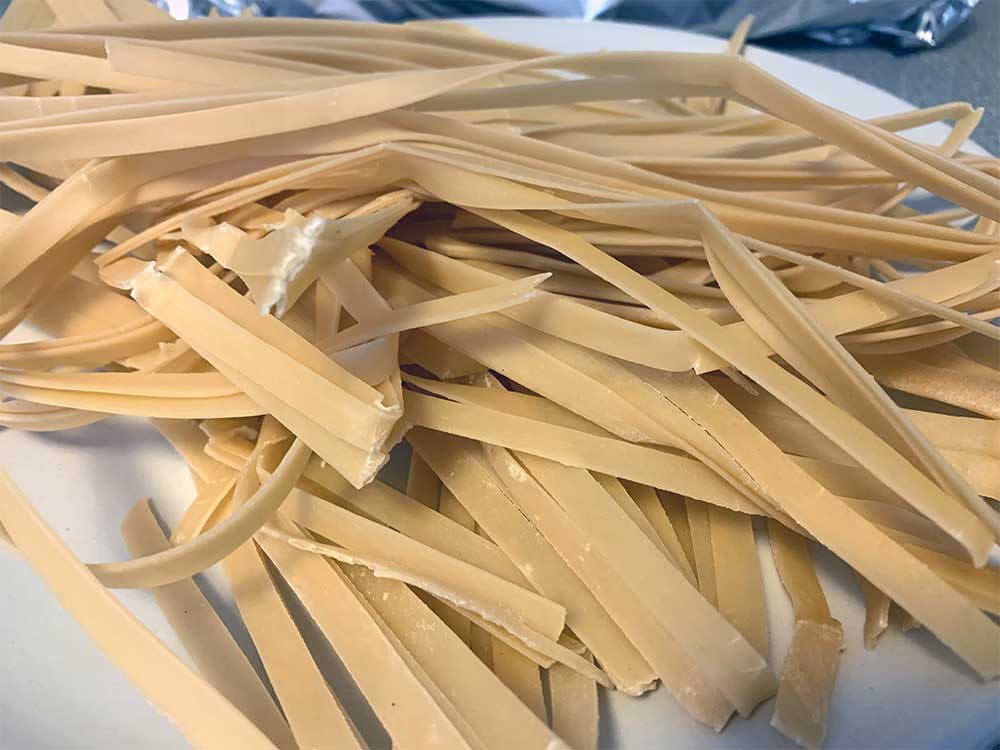You don’t need to be an expert to make pasta by hand all you need is flour and eggs and some time. Making fettuccine at home by hand is one of the most fun and most rewarding cooking experiences of all time in my honest opinion, plus you probably already have the ingredients at home.
Pasta to me is such a great symbol for what Italian food really is; all of the classic Italian recipes are so incredibly simple, yet all the flavours work so harmoniously and perfectly, and more importantly it’s about the freshness and the quality of the ingredients over the amount of ingredients. That’s what I love about Italian food beauty and simplicity.
Today we will make an all-purpose pasta dough, and then make fettuccine. That’s right; this pasta dough can be made into many many shapes, like ravioli, spaghetti, fettuccine; you name it.
It all begins with three cups (480 grams) of OO type flour. You can find this flour at most supermarkets, however if you can’t find it, then you can totally use a plain or all-purpose flour.
Now the first thing you’re going to do, is you’re going to dump that flour out onto a flat surface into a mound shape. Sprinkle a half a teaspoon (two grams) of fine sea salt using your hand. Make a well in the mound of flour, large enough to hold around five eggs, then crack five large whole eggs into the well of that flour.
Now you should drizzle in a teaspoon (5 grams) of extra virgin olive oil. Using a fork, start gently whisking the eggs until they come together cohesively. Once the eggs have come together, you’re going to keep whisking.
As you are whisking, slowly flicking a little bit of flour on the sides, being careful not to make a hole or a dent in the centre, otherwise all your eggs will run out. As you do this, you’ll notice that it slowly becomes a paste and then it starts to clump together and then it starts to become a dough.
Once it becomes a dough, then you’re going to start using your hands so you can take the fork out and then start mixing it and squeezing it together with your hands. Once it’s completely combined, you’re going to begin kneading it. You will knead this dough from 5-10 minutes until it is beautifully silky smooth.
Now, if for some reason your dough is a little too dry, you can add a tablespoon of water at a time until it comes together.
Once your dough is nice and kneaded, you’re going to go ahead and wrap it in plastic wrap. Make sure that it’s airtight, you do not want this to dry out and let it sit out at room temperature for at least an hour (or overnight in the fridge) and that’s it – there you have your all-purpose pasta dough.

Now we’re going to make fettuccine aka tagliatelle, it’s really regional I mean there’s not much of a difference between them. Some people say that one is thinner than the other, but it really just depends on the region that you get it from.
To start making fettuccine, as with any pasta, you’re going to lightly dust your dough with flour and then divide it into four equal pieces. Then you’re going to roll that dough out until it’s about a quarter of an inch oval.
Now pass it through your pasta roller on the widest setting, then fold it like a letter and pass it through the roller once more. Now begin passing the dough through the machine, working down each thinness setting, one setting at a time, until you reach the thinnest or the thickness setting that you want.
If it starts to stick in the rollers, dust with flour as needed, so you know your dough doesn’t stick. When you are doing this, just handle the dough very gently, basically just letting it drape over your hands, rather than holding it with your fingertips.
Now, to make the noodles for making fettuccine at home, you can either use your pasta machines attachment, or you can simply take a sheet and roll it up lengthwise until you get a tube – think of it as a savoury pasta version of a fruit roll-up – then using a sharp knife, saw a way to cut 1/2 inch segments of that tube. These will be your individual noodles.
Now the attachment part is pretty straightforward; just make sure that your pasta sheet is very generously dusted with flour otherwise it will stick in the attachment. Now simply run it through the fettuccine attachment, and bingo! fettuccine comes out the other end.
Remember, as mentioned before, when making fettuccine at home, always make sure to toss generously with flour. Then you’re ready to put it in boiling water, add your sauce and then serve with a glass or two of great Australian wine.
Buon Appetito!






